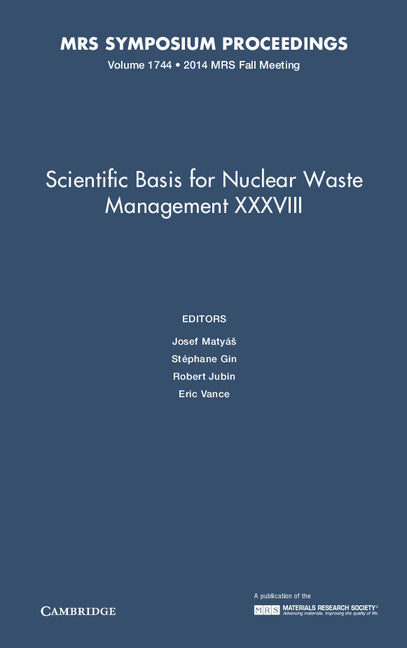Freshly Printed - allow 8 days lead
Couldn't load pickup availability
Scientific Basis for Nuclear Waste Management XXXVIII: Volume 1744
Symposium EE, entitled 'Scientific Basis for Nuclear Waste Management XXXVIII', was held from 30 November to 5 December 2014, at the MRS Fall Meeting in Boston.
Josef Matyáš (Edited by), Stéphane Gin (Edited by), Robert Jubin (Edited by), Eric Vance (Edited by)
9781605117218, Materials Research Society
Hardback, published 16 September 2015
260 pages, 127 b/w illus. 48 tables
23.5 x 15.8 x 1.8 cm, 0.49 kg
The Materials Research Society's Symposium EE, entitled 'Scientific Basis for Nuclear Waste Management XXXVIII', was held from 30 November to 5 December 2014, at the MRS Fall Meeting in Boston, Massachusetts. The symposium discussed the key scientific challenges for the safe and effective management of spent nuclear fuel and radioactive waste and provided an overview of the international research and waste management programs around the world. Waste forms and engineered barrier system properties, interactions between engineered and geological systems, radiation effects, chemistry and transport of radionuclides, and long-term predictions of repository performance were just some of the topics presented at the symposium by internationally renowned speakers and leading researchers in the field. The symposium attracted 85 abstracts. This proceedings volume contains 31 papers from the meeting.
Part I. Capture and Immobilization of Radionuclides: 1. Current status of immobilization techniques for geological disposal of radioactive iodine in Japan
2. French studies on the development of potential conditioning matrices for iodine 129
3. Effects of hydrosulfide and pH on iodine release from an alumina matrix solid confining silver iodide
4. Evaluation of sorption behavior of iodide ions on calcium silicate hydrate and hydrotalcite
5. Study of the release of the fission gases (Xe and Kr) and the fission products (Cs and I) under anoxic conditions in bicarbonate water
6. Technetium getters to improve cast stone performance
7. Selective ordering of pertechnetate at the interface between amorphous silica and water: a Poisson Boltzmann treatment
Part II. Development and Characterization of Waste Forms: 8. Pressureless sintering of sodalite waste-forms for the immobilization of pyroprocessing wastes
9. MoO3 incorporation in alkaline earth aluminosilicate glasses
10. Valence and local environment of molybdenum in aluminophosphate glasses for immobilization of high level waste from uranium-graphite reactor spent nuclear fuel reprocessing
11. Copper valence and local environment in aluminophosphate glass-ceramics for immobilization of high level waste from uranium-graphite reactor spent nuclear fuel reprocessing
12. Nepheline crystallization in high-alumina high-level waste glass
13. Wet chemical and UV-Vis spectrometric iron speciation in quenched low and intermediate level nuclear waste glasses
14. A sampling method for semi-quantitative and quantitative electron microprobe analysis of glass surfaces
15. The void fraction of melter feed during nuclear waste glass vitrification
16. Charge compensation in trivalent doped Ca3(SiO4)Cl2
17. Effect of charge-balancing species on Sm3+ incorporation in calcium vanadinite
Part III. Corrosion Behavior of Materials: 18. Key phenomena governing HLW glass behavior in the French deep geological disposal
19. Glass corrosion in the presence of iron-bearing materials and potential corrosion suppressors
20. Uncertainty in the surface area of crushed glass in rate calculations
21. About U(t) form of pH-dependence of glass corrosion rates at zero surface to volume ratio
22. Glass degradation in performance assessment models
23. Hierarchical modeling of HLW glass-gel-solution systems for stage 3 glass degradation
24. Solution composition effects on the dissolution of a CeO2 analogue for UO2 and ThO2 nuclear fuels
Part IV. Storage and Disposal of Nuclear Waste: 25. Deep borehole disposal research: what have we learned from numerical modeling and what can we learn?
26. Characteristics of cementitious paste for use in deep borehole disposal of spent fuel and high level wasteforms
27. Physicochemical properties of vitrified forms for LILW generated from Korean nuclear power plant
28. Release of 108Ag from irradiated PWR control rod absorbers under deep repository conditions
29. Advancing the modelling environment for the safety assessment of the Swedish LILW repository at Forsmark
30. Analysis of radionuclide migration with consideration of spatial and temporal change of migration parameters due to uplift and denudation
31. Pore and mineral structure of rock using nano-tomographic imaging.
Subject Areas: Materials science [TGM], Mechanical engineering & materials [TG]


